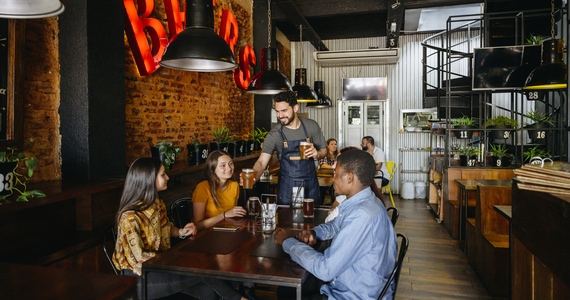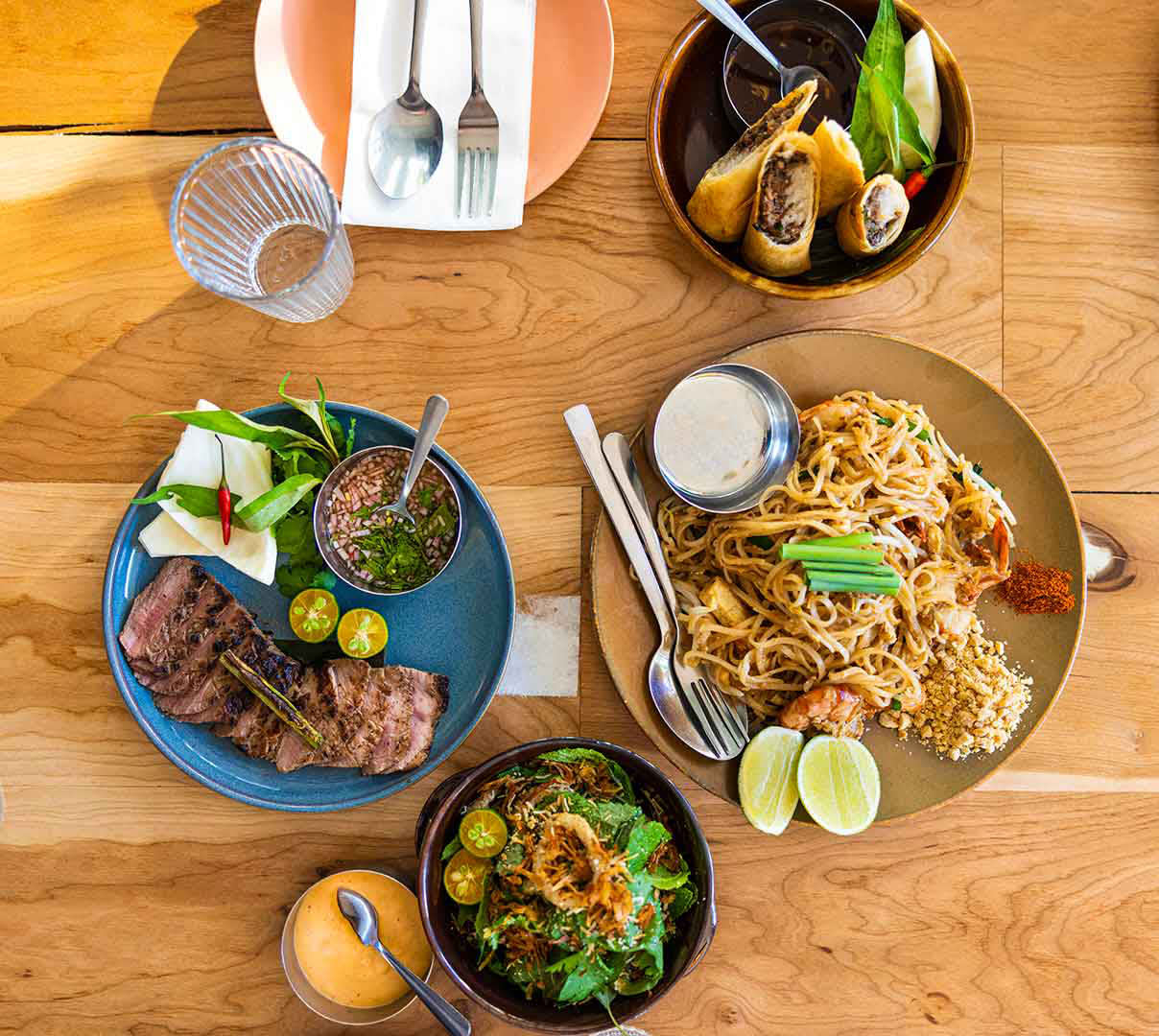Top Restaurants where heritage meets creativity
Top Restaurants where heritage meets creativity
Blog Article
Eating Delights: Check Out Innovative Restaurants Changing the Food Scene
The modern eating landscape is experiencing a remarkable improvement, noted by ingenious dining establishments that are redefining culinary norms. From the surge of pop-up facilities accepting seasonal ingredients to immersive experiences that involve the senses in extraordinary methods, these venues are establishing new criteria wherefore it implies to enjoy a meal. Furthermore, a growing focus on sustainability and local sourcing shows a commitment to both top quality and community. As we check out these trends, the concern develops: what future advancements might additionally improve our cooking experiences?
The Rise of Pop-Up Restaurants
As the culinary landscape develops, pop-up restaurants have actually emerged as a vibrant force, enchanting food lovers and business owners alike. These short-lived dining facilities, usually established in unique spaces, use an one-of-a-kind blend of creative thinking and accessibility, appealing to a varied variety of customers. The rise of pop-up restaurants can be credited to several aspects, consisting of the growing demand for unique dining experiences and the business spirit of chefs keen to check their culinary ideas without the monetary concern of an irreversible location.Pop-up dining establishments enable chefs to explore menus, designs, and themes, usually focusing on seasonal or locally-sourced ingredients. This versatility not only cultivates technology however also creates a feeling of seriousness, as patrons are drawn to the limited-time offerings. The ephemeral nature of pop-ups grows a buzz around the eating experience, encouraging social media sharing and word-of-mouth promo, which can significantly enhance visibility and attract a loyal following.Furthermore, pop-up restaurants commonly satisfy niche markets, ranging from vegan and gluten-free alternatives to ethnic foods, thereby meeting the diverse nutritional preferences of modern-day customers. Consequently, these establishments add to the rich tapestry of the food scene, pushing borders and difficult typical notions of dining.
Immersive Eating Experiences

Sustainable Practices in Cuisine
Accepting sustainability, ingenious dining establishments are redefining their cooking methods to minimize ecological effect while boosting the eating experience. These facilities focus on regional sourcing, frequently teaming up with nearby farmers and producers to assure that active ingredients are fresh and seasonal. This not just lowers the carbon footprint related to long-distance transport but also sustains neighborhood economies.In addition to sourcing, restaurants are significantly taking on practices that reduce waste. Several are carrying out composting systems and using food scraps artistically, transforming what would generally be disposed of into delicious elements of new dishes. For instance, vegetable trimmings can locate new life in supplies or garnishes, while stagnant bread is repurposed right into croutons or bread puddings.Moreover, the trend in the direction of plant-based food selections is gaining momentum (Restaurants). By highlighting veggies, grains, and beans, dining establishments can considerably reduce their ecological influence, as plant-based foods typically call for fewer resources and generate much less greenhouse gas emissions compared to meat production. Cutting-edge chefs are crafting dishes that not just commemorate these active ingredients but likewise provide diners with an extraordinary cooking experience.Furthermore, numerous establishments are adopting eco-friendly techniques such as using naturally degradable product packaging for takeout and investing in energy-efficient home appliances. These steps reflect a dedication to sustainability at every degree of procedure, enabling diners to appreciate their dishes with the understanding that their choices add to a much healthier earth. As the food scene remains to develop, the combination of sustainable techniques ends up being not just a trend, but an essential criterion for the future of dining
Tech-Enhanced Dining Adventures
Tech-enhanced dining experiences are revolutionizing the method patrons experience meals, with over 70% of dining establishments now incorporating digital advancements to raise solution and engagement. These improvements are not merely trends; they are fundamental changes that redefine the cooking landscape. From the minute restaurants enter a restaurant, innovation is perfectly woven into the experience, improving both benefit and enjoyment.One of the most noteworthy advancements is making use of mobile applications for reservations and food selection surfing. Restaurants can currently check out in-depth summaries, dietary details, and also the beginnings of ingredients at their fingertips. This transparency fosters educated selections and allows guests to customize their dining experience to their preferences.Furthermore, interactive tables equipped with touchscreens give an interesting platform for buying and enjoyment. Restaurants can personalize their meals, check out red wine pairings, or perhaps play video games while waiting for their recipes. This integration of technology not just enhances the purchasing procedure but likewise transforms eating into a vibrant, common activity.Moreover, some facilities are making use of increased reality (AR) to develop immersive eating experiences. By just directing a smartphone at a dish, clients can imagine the ingredients and cooking methods in an engaging way, bridging the gap in between the cooking and digital worlds.As restaurants continue to embrace these technological advancements, the dining experience comes to be increasingly tailored, effective, and satisfying. This improvement shows a more comprehensive fad in the direction of improving client engagement, making certain that each meal is not nearly nourishment, yet a memorable experience in eating.
Global Tastes With a Spin
The cooking landscape is progressively noted by combination food innovations that blend traditional tastes with unforeseen aspects - Best Restaurants. Special ingredient pairings not only improve the eating experience yet likewise admire cultural heritage, reimagining cherished recipes in interesting new means (Eddie's Rise N' Dine Williamsville IL). This imaginative technique invites restaurants to explore diverse worldwide influences while experiencing familiar tastes in a fresh context
Blend Food Innovations
Imagination in the culinary arts has resulted in a dynamic revival of fusion cuisine, where cooks mix diverse international flavors to develop cutting-edge dishes that oppose traditional borders. This culinary movement goes beyond mere mix, concentrating on the harmonious integration of components and methods from different cultures.Restaurants concentrating on fusion food are redefining eating experiences by offering recipes that inform a tale with flavor, method, and discussion. The marital relationship of Japanese sushi with Peruvian ceviche has actually resulted in special rolls that commemorate both culinary heritages. Indian seasonings have found their way into Italian pasta meals, supplying a fascinating spin on traditional recipes.Chefs are likewise exploring with food preparation methods, such as making use of typical wok methods to prepare Latin American stir-fries, consequently producing a rich tapestry of preferences and appearances. Seasonal availability of active ingredients additionally boosts this creative process, permitting fresh analyses of time-honored meals. The appeal of blend cuisine exists in its capacity to surprise and joy the palate, encouraging restaurants to explore brand-new cooking landscapes while fostering a better gratitude for the diversity of global gastronomy.
Unique Active Ingredient Pairings
Cooking technology often thrives on the unforeseen, and special active ingredient pairings go to the center of this pattern in the contemporary eating landscape. Cooks are progressively explore mixes that amaze and thrill the palate, elevating the eating experience beyond typical boundaries.For example, the juxtaposition of sweet and mouthwatering has ended up being a characteristic of contemporary food. American Restaurant. Consider crunchy duck offered with a cherry and balsamic polish, where the flavor of the cherries matches the splendor of the meat. Dishes featuring miso-infused chocolate treats showcase just how umami can improve sweet taste, producing a well balanced taste profile that intrigues diners.Furthermore, the use of unconventional flavors in unforeseen contexts, such as saffron in a classic risotto combined with lemon passion, highlights how cooking boundaries can be redefined. These cutting-edge pairings not just produce visual and textural contrasts yet likewise welcome diners to discover a range of worldwide flavors in a single dish.As restaurants continue to forge ahead, the adventure of uncovering new preferences through unique ingredient pairings assures to be a specifying function of the modern food scene, welcoming adventurous eaters to enjoy these creative culinary dialogues
Social Heritage Reimagined

The Art of Multi-Sensory Meals
In the domain name of culinary advancement, multi-sensory dishes are reinventing the dining experience by intertwining taste and fragrance in charming means. The influence of aesthetic presentation improves not just the visual allure yet likewise the understanding of preference, while very carefully curated soundscapes elevate the setting. With each other, these elements develop an all natural experience that engages all detects, transforming how patrons connect with food.
Taste and Aroma Combination
An expanding variety of chefs are accepting the idea of flavor and fragrance fusion, acknowledging that a meal is not just a combination of active ingredients however a holistic experience that engages all the senses. This ingenious approach highlights the elaborate relationship between preference and smell, both of which greatly affect our understanding of food.Chefs are experimenting with different strategies to boost flavors while concurrently crafting aromatic profiles that elevate the dining experience. The usage of fragrant herbs and flavors not just includes deepness to dishes but likewise tantalizes the olfactory detects, creating a more immersive experience. Mixtures, smoke, and vital oils are significantly preferred, allowing cooks to manipulate aroma and improve the overall flavor profile.Moreover, the calculated pairing of complementary and contrasting tastes can stimulate emotional feedbacks, transforming a dish right into a memorable occasion. Restaurants are urged to appreciate each bite, as the interaction of flavors and aromas unfolds, welcoming them to check out brand-new dimensions of taste. This thoughtful amalgamation of sensory components cultivates an appreciation for the virtuosity of cuisine, placing flavor and aroma combination as a pivotal fad in contemporary gastronomy.
Aesthetic Presentation Impact
Beyond taste and aroma, the aesthetic presentation of a dish plays an essential function in the general dining experience. The aesthetic appeals of food can evoke feelings, set the tone for the meal, and improve the anticipation of tasting. Cutting-edge dining establishments are progressively identifying that a meal's look can affect visitors' perceptions and complete satisfaction degrees, sometimes even prior to the first bite is taken.Artful plating strategies, dynamic color mixes, and imaginative garnishes contribute to a meal's aesthetic allure. Cooks are now educated not just in culinary skills, but likewise in the art of discussion, commonly drawing ideas from numerous imaginative disciplines. As an example, the use of negative space in plating assists to develop centerpieces, enabling the components to shine.Moreover, the pattern of multi-sensory meals incorporates visual aspects with various other detects, such as structure and temperature level, to produce an alternative eating experience. This strategy urges diners to engage more deeply with their food, transforming an easy meal right into an unforgettable event. Fundamentally, the aesthetic presentation of food is not just a visual venture; it is an important component of the eating experience that can boost a dish from normal to remarkable.
Soundscapes in Eating
The experience of eating extends past the visual aspects of a meal; audio likewise plays a substantial function fit just how food is viewed and appreciated. Cutting-edge restaurants are significantly discovering the principle of soundscapes-- curated audio atmospheres developed to enhance the eating experience (Breakfast Served Near Me). The interaction of audio and taste can greatly influence an individual's perception of flavor, structure, and overall satisfaction.Research suggests that particular sounds can intensify or reduce tastes. Shrill noises may improve sweet taste, while lower regularities can enhance resentment. This sensation has actually led some chefs and restaurateurs to collaborate with audio developers, developing distinct auditory backdrops that match their cooking offerings. Restaurants.In these setups, diners might discover themselves involved in a meticulously crafted sound atmosphere, ranging from the gentle rustle of leaves to the balanced sounds of a bustling kitchen. Such multisensory dishes not just involve the taste buds but likewise stimulate psychological responses, improving the total experience. By taking advantage of the power of sound, these innovative eating establishments are redefining the method we experience food, urging patrons to appreciate each bite while totally involving their detects
Community-Centric Culinary Efforts
Regularly, innovative dining establishments are redefining their duties within regional communities by carrying out culinary initiatives that focus on social responsibility and inclusivity. These facilities are progressively interesting in techniques that not just boost their business designs but additionally add to the welfare of their neighborhoods.One popular fad is the establishment of community kitchens that offer culinary training and task placement for underserved populations. These cooking areas not just give important abilities however likewise cultivate a feeling of belonging, encouraging people to produce their own cooking paths. Furthermore, numerous restaurants are partnering with neighborhood ranches and manufacturers, stressing farm-to-table methods that support sustainable agriculture and decrease carbon footprints. This not only assures quality and quality but additionally reinforces neighborhood economies.Another campaign getting grip is the principle of public eating experiences, where varied teams collaborated to share dishes and stories. This technique grows understanding and gratitude amongst different societies, damaging down obstacles and cultivating inclusivity. In addition, dining establishments are significantly taking on waste reduction methods, such as composting and recycling food scraps, which not only addresses environmental worries yet additionally motivates customers to review their consumption routines.
Frequently Asked Inquiries
How Do Cutting-edge Dining Establishments Maintain Uniformity in Food Top Quality?

What Are the Costs Related To Starting a Pop-Up Dining Establishment?
Starting a pop-up restaurant entails various costs, consisting of place leasing, devices purchases, allows, marketing, staffing, and food materials. Furthermore, business owners need to allocate unforeseen costs to guarantee smooth operations throughout the endeavor's duration.
Exactly How Do Dining Establishments Select Their Places for Pop-Up Occasions?
Dining establishments select pop-up event locations based upon target demographics, foot traffic, ease of access, and competitors. Furthermore, they think about regional market trends and area involvement opportunities to optimize visibility and improve consumer experience during the occasion.
What Effect Do Food Trends Have on Dining Establishment Menus?
Food patterns substantially influence dining establishment menus by directing component choice, affecting meal imagination, and forming customer preferences. Establishments usually adapt to these trends to improve customer charm, preserve competition, and straighten with advancing culinary expectations.
How Can Diners Support Community-Centric Culinary Initiatives?
Restaurants can support community-centric cooking efforts by patronizing local dining establishments, joining farm-to-table events, engaging with food cooperatives, advertising sustainable techniques, and promoting for policies that strengthen local food systems and boost community health.
Report this page